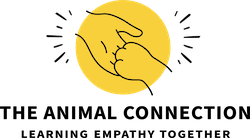What's Included in The Animal Connection?
Our Curriculum at a Glance
Lesson 1: Introduction to The Animal Connection
This video introduces students to the program’s humane education teachers and some registered therapy dogs they will meet throughout the curriculum. Descriptions of the topics to be covered in the lessons are provided.
Lesson 2: Care and Responsibility
This lesson teaches students that everything we need to be happy and healthy as humans is the same thing companion animals need. However, they cannot provide for themselves and rely on their guardians to care for them. The length of the commitment to a companion animal is demonstrated through a “Life Timeline,” indicating the changes that will take place in students’ lives throughout the life span of various companion animals.
Lesson 3: Life and Death in the Shelter
In this video, students experience a loose companion animal's process from being picked up off the street, transported, scanned for a microchip, tagged, licensed, and impounded. The video shows the day-to-day existence of cats and dogs and what happens if the shelter becomes overcrowded. The term “euthanasia” is taught, and the humane conditions under which it is done are explained.
Lesson 4: The Need for Spaying and Neutering
Building on the preceding class, “Life and Death in the Shelter,” students learn why spaying and neutering companion animals are necessary. The video shows in a non-graphic way the preparation, surgery, and recovery process the animal experiences. Through illustrations showing multiplication, students learn to extrapolate litter numbers to understand why shelters are often overwhelmed and unable to care for all the animals they receive, resulting in the preventable practice of euthanasia.
Lesson 5: The Consequences
of Dog Chaining
This lesson explains the dangers of dog chaining to both people and dogs and discusses alternatives to chaining. Students will see what life is like for a chained dog and learn about common injuries and how it affects a dog’s temperament. Students will also learn the difference between “fight” and “flight” and why using trolley systems or electric fences are dangerous for dogs.
Lesson 6: Loose Dog & Bite Safety
This lesson teaches students how to read dogs’ and cats’ behaviors to determine when to leave them alone and how to play with them safely. Special emphasis is given to precautions when around unknown and loose dogs. Methods of protection from loose dogs and aggressive and biting dogs are demonstrated. Teachers are encouraged to have students practice their newly acquired skills involving feeding, giving a treat, and playing with an animal, as well as appropriate behavior around loose and/or aggressive/biting dogs.
Lesson 7: Bloodsport
This lesson discusses the illegal activities of training dogs and roosters to fight. The video covers the history of dog- and cockfighting, the cruel methods and equipment used to train the animals, and how to report animal cruelty safely and suspected dog- or cockfighting. The images shown are not graphic but may nevertheless disturb some students.
Lesson 8: The Link Between Animal
Abuse and Other Forms of Violence
Lesson 9: Careers in Animal Welfare
Lesson 10: Sherpa's Farm
The Animal Connection, Jr.: Reading to Dogs

